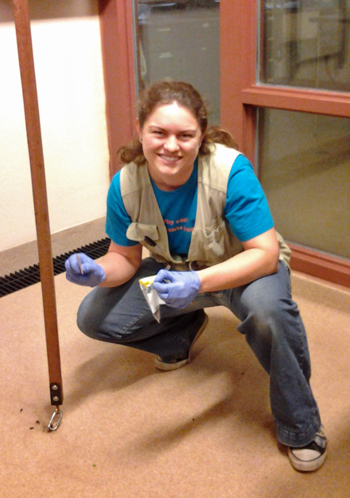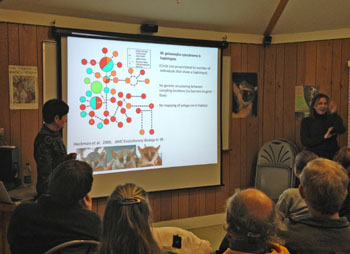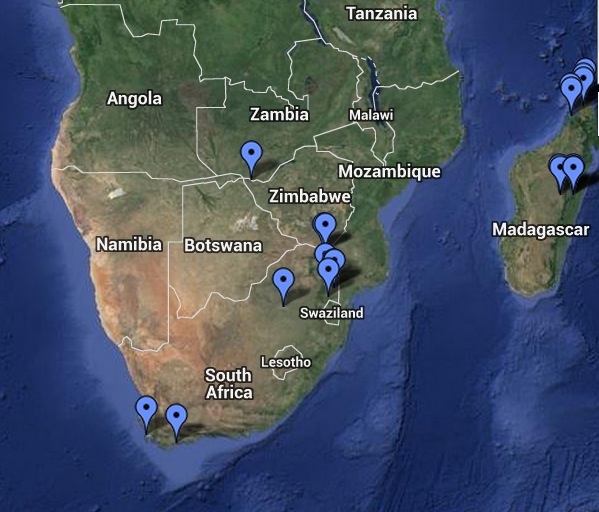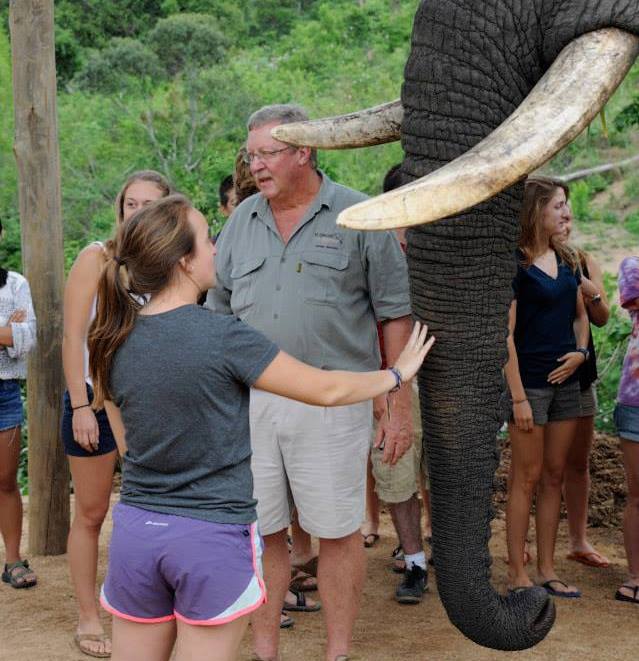Elphaba the aye-aye is not an early riser. A nocturnal primate with oversized ears, bulging eyes and long, bony fingers, she looks like the bushy-tailed love child of a bat and an opossum.
She would much rather sleep in than participate in Duke alum Joe Sullivan’s early morning vision tests.
“I can’t blame her,” said Sullivan, who graduated from Duke in 2015.
Elphaba is one of 14 aye-ayes at the Duke Lemur Center in Durham, North Carolina, where researchers like Sullivan have been trying to figure out if these rare lemurs can tell certain colors apart, particularly at night when aye-ayes are most active. But as their experiments show, testing an aye-aye’s eyesight is easier said than done.

Elphaba the aye-aye takes a vision test at the Duke Lemur Center in Durham, North Carolina. She’s getting encouragement from student researcher Joe Sullivan and technician Jennifer Templeton. Photo by David Haring.
Aye-ayes don’t see colors as well as humans do. While we have genes for three types of color-sensing proteins in our eyes, aye-ayes and most other mammals have two, one tuned to blue-violet light and another that responds to green.
In all animals, the eyes’ color-detecting machinery depends on medium to bright light. In a version of “use it or lose it,” the genes responsible for color vision in some nocturnal species have decayed over time, such that they see the world in black and white.
But in aye-ayes, research shows, the genes for seeing colors remain intact, and scientists at Duke and elsewhere are trying to understand why.
One possibility is the aye-aye’s color vision genes are mere leftovers, relics passed down from daylight-loving ancestors and no longer useful to aye-ayes today.
Or, the genes may have been preserved because color vision gives aye-ayes an edge. Wild aye-ayes live by eating fruit, nuts, nectar and grubs in the rainforests of Madagascar. Wouldn’t an animal that could distinguish the blue fruits of a favorite snack like the Traveler’s palm from the green of the surrounding foliage have an advantage?
Understanding what aye-ayes can see is no easy feat. One of the most common tests for colorblindness, the Ishihara, requires the subject to recognize and identify numbers hidden within a patch of colored dots of different sizes and brightness.
Aye-ayes don’t read numbers, so Sullivan tests for color vision using food and colored cards.
The first tests were simple enough. In a dimly lit enclosure, a trainer held up two cards: a white card and a black one.
Each time the aye-ayes chose the white card over the black one by reaching out and touching it with their hand, the animal got a peanut.
Even animals with no color vision can tell white from black, so Sullivan was confident they’d ace the test. But aye-ayes aren’t programmed to please. Just getting them to sit still, instead of running around their enclosure, was a challenge.
One aye-aye, 29-year-old Ozma who was born in the wild in Madagascar, never got the hang of even the most basic task, a warmup involving a single white card.
“That’s when I realized that aye-ayes don’t always play by my rules,” said Sullivan, who started working at the Duke Lemur Center as an undergraduate research intern in 2012.
After four months and 200 trials, all five of the aye-ayes in Sullivan’s study started picking the white card more often than not, with Merlin, Elphaba and Grendel passing the test at least 70 percent of the time.
Norman and Ardrey tended to reach for the card on their left, no matter what the color.
Sullivan isn’t giving up. Still working at the Duke Lemur Center post-graduation, now he’s trying to see if aye-ayes can distinguish a purplish card from a green one, in brighter light more similar to dawn or dusk.
So far, Merlin and Grendel are getting it right just over half the time, leaving Sullivan still unsure if the aye-ayes are choosing the cards by their colors or by some other cue.
“I came in thinking that the aye-ayes were going to play nice and do everything I wanted. That was so wrong,” Sullivan said. “Still, they’ve been very good sports.”

How do you give a lemur a vision test? Photo by David Haring, Duke Lemur Center.
Post by Robin A. Smith 




 Post by Devin Nieusma, Duke 2019
Post by Devin Nieusma, Duke 2019


















